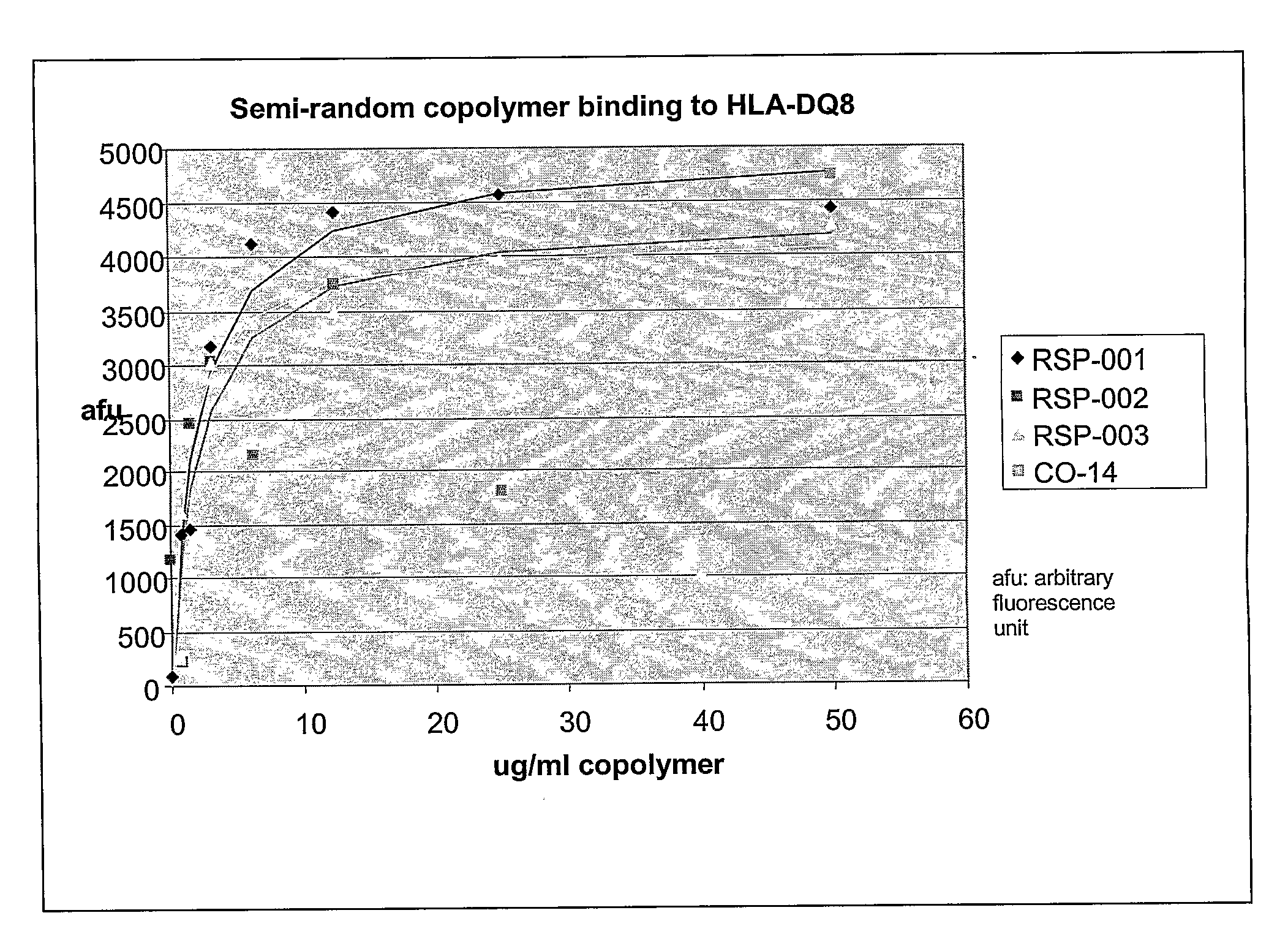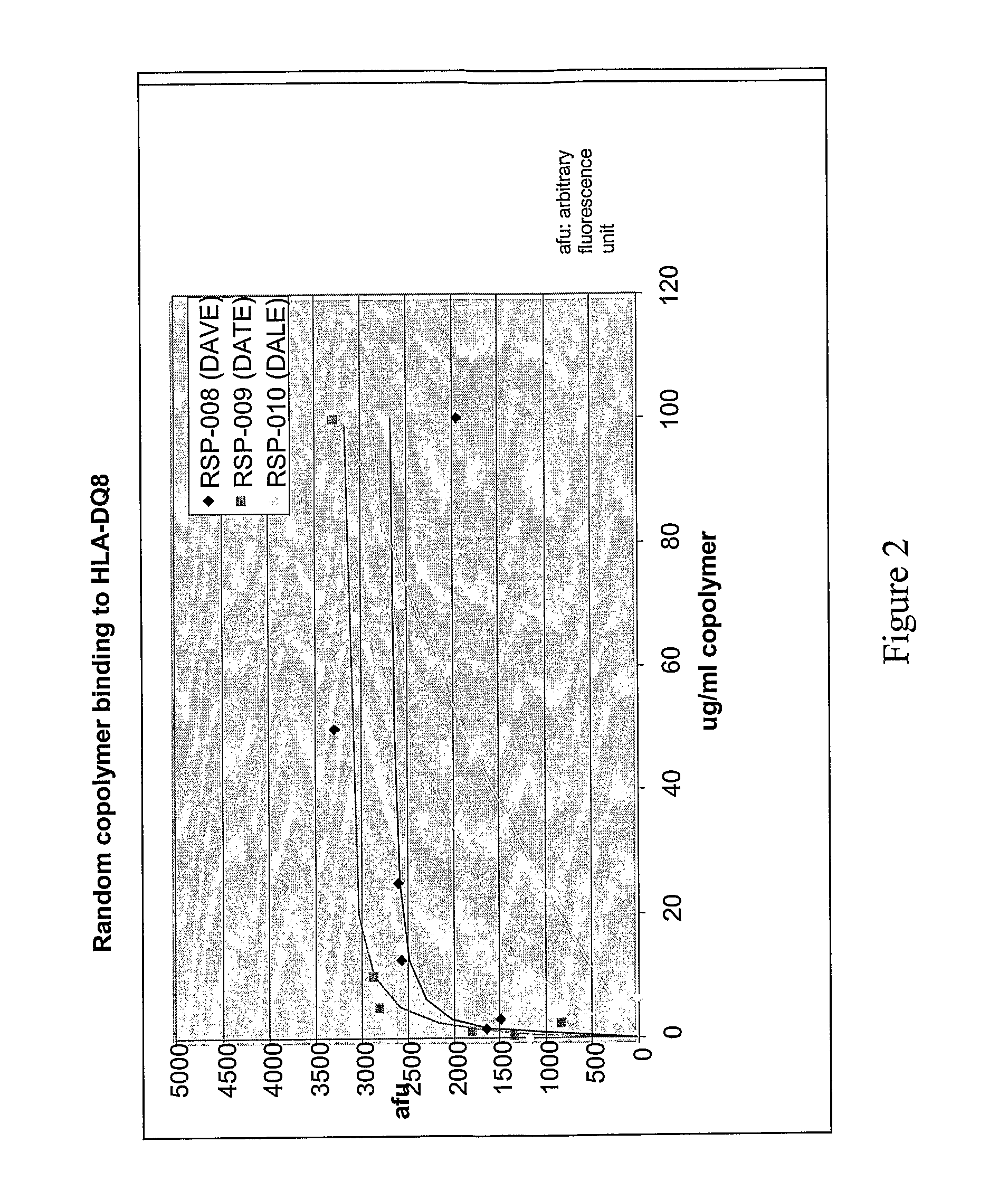Methods and Compositions for Treatment of Autoimmune Diseases
a technology for autoimmune diseases and compositions, applied in the field of methods and compositions for treating autoimmune diseases, can solve the problems of increasing insulin deficiencies, reducing blood glucose concentrations to dangerous levels, and inducing hypoglycemia, so as to prevent autoimmune responses
- Summary
- Abstract
- Description
- Claims
- Application Information
AI Technical Summary
Benefits of technology
Problems solved by technology
Method used
Image
Examples
example 1
Binding of Copolymers to HLA-DQ
[0302]The ability of these new copolymers to bind to HLA-DQ molecules are tested by competitive binding assays in which the copolymer competes with a peptide derived from islet autoantigen, examples of which are listed above, for binding to soluble, recombinant HLA-DQ8 molecule. The soluble recombinant HLA-DQ8 encoded by alleles DQA1*03-DQB1*0302 was expressed in Drosophila melanogaster S2 cells under the control of the copper-inducible metallothionein promoter. HLA-DQ8 was engineered to be a soluble protein by replacing the transmembrane and intracellular segments of DQ α and DQ β with leucine zipper dimerization domains from the transcription factors Fos and Jun. See Hausmann et al. (1999) J. Exp. Med. 189: 1723-1734. The expressed recombinant protein was purified from the concentrated supernatants by affinity chromatography using monoclonal antibody 9.3.F10 (HB 180, American Type Culture Collection) and anion-exchange chromatography using Mono Q HR ...
example 2
Peptides Bound to Human Class II MHC HLA-DQ8
[0321]Copolymers, peptides and antibodies. Peptides were synthesized using solid phase techniques (Barany, G., and R. Merrifield. 1979. Academic Press, New York, N.Y.) on an Applied Biosystems Peptide Synthesizer and purified by reversed-phase HPLC(RP-HPLC).
[0322]A “humanized” mouse model of diabetes in which the mice lack endogenous class II genes but transgenetically express human HLA-DQ8 and DR3 proteins is used in the studies herein. GAD65 is injected into these transgenic mice which are thus immunized with GAD65. HLA-DR3 and DQ8 and their bound peptide fragments from GAD65 are purified from mouse spleen and lymph nodes after the appearance of GAD65 antibody. The obtained peptide pool is fractionated and the T-cells generated from the immunized transgenic mice are tested for their response to these peptides. Whether GAD65 peptides are presented by both DR and DQ proteins in these transgenic animals is determined, and the sequences of ...
example 3
Analysis of Peptide Sequences
[0331]The eluted peptides were found to be generally acidic, with surprising overrepresentation of both aspartic acid (D) and glutamic acid (E). Alignment of the peptides with E or D near the carboxy terminus of the core, i.e., at P9, is shown in Table 6. A preference for an acidic amino acid at P1 was also evident in the alignment which is more than that observed with mouse protein I-Ag7 (Suri et al. (2002) J. Immunol. 168(3):1235-43). The distinction between preferences from one species to another may be especially significant for immune recognition.
TABLE 6Alignment of sequences of selected peptidesobtained from complexes with HLA-DQ8 in thehomozygous Priess cell lineSEQ# ofIDnestedCore PeptideSource ProteinNOpeptidesLPSDSQDLGQHGLEEproteoglycan 1123 WAAVVVPSGEEclass I MHC220 FDAGAGIALNDHglyceraldehyde-3-33phosphatedehydrogenase GPIDGPSKSGAEEtrans-Golgi network41protein (TGN 51) DEDGDLVAFSSDEEp6057 INWLDKNQTAEKEEFEH71 kDa heat shock65protein LY...
PUM
| Property | Measurement | Unit |
|---|---|---|
| Fraction | aaaaa | aaaaa |
| Density | aaaaa | aaaaa |
| Density | aaaaa | aaaaa |
Abstract
Description
Claims
Application Information
 Login to View More
Login to View More - R&D
- Intellectual Property
- Life Sciences
- Materials
- Tech Scout
- Unparalleled Data Quality
- Higher Quality Content
- 60% Fewer Hallucinations
Browse by: Latest US Patents, China's latest patents, Technical Efficacy Thesaurus, Application Domain, Technology Topic, Popular Technical Reports.
© 2025 PatSnap. All rights reserved.Legal|Privacy policy|Modern Slavery Act Transparency Statement|Sitemap|About US| Contact US: help@patsnap.com



